Thanksgiving: the traditions, myths and strange customs
America’s national holiday is full of history but like most traditions has its fair share of untruth

The US is today celebrating Thanksgiving, a holiday believed to be observed by more Americans than Christmas, but one watched with bafflement by much of the rest of the world.
Most people outside America know it to be a day filled with family and food, but where does the whole idea come from?
What is Thanksgiving and how do Americans mark the occasion?
The Week
Escape your echo chamber. Get the facts behind the news, plus analysis from multiple perspectives.

Sign up for The Week's Free Newsletters
From our morning news briefing to a weekly Good News Newsletter, get the best of The Week delivered directly to your inbox.
From our morning news briefing to a weekly Good News Newsletter, get the best of The Week delivered directly to your inbox.
When is it?
This year Thanksgiving is on 28 November, the day before Black Friday.
In 1863, during the American Civil War, Abraham Lincoln proclaimed a national Thanksgiving Day to be held each year on the final Thursday of November.
In 1939, Franklin D. Roosevelt moved that date to the third Thursday of the month, in an effort to give retailers a longer period to sell goods for Christmas. In 1941, Congress passed a law making it the fourth Thursday of November.
A free daily email with the biggest news stories of the day – and the best features from TheWeek.com
What is the history of the holiday?
It dates back to the arrival of English settlers, the Pilgrim Fathers, who founded New Plymouth, today’s Massachusetts, in 1620.
Their first winter in the New World proved extremely difficult, with half of the group reportedly starving to death after a poor harvest. The story goes that Native Americans stepped in to help and that, as a sign of gratitude, the Pilgrims invited them to join a three-day feast during the more successful 1621 harvest season.
While this version of events is written into the myth of America, “there’s no indication that the Native Americans were actually invited”, says Fortune.
Isn't there also a darker side?
Symbolising the first meeting between European settlers and the indigenous population, later Thanksgivings were used to commemorate the military victory over native tribes.
Some people hold Unthanksgiving Day events in protest at the real story behind Thanksgiving. The events – which originated from a meeting held on Alcatraz Island in San Francisco Bay – are designed to commemorate the survival of Native American tribes following the European colonisation of the Americas.
How is Thanksgiving celebrated?
Thanksgiving is famously marked with a huge amount of food. The traditional dinner features turkey, stuffing, vegetables and a variety of sweet treats.
Some cities across the US also hold a Thanksgiving Day parade, the most famous of which is in New York. The event “features floats, costumes and huge helium balloons in the shape of cartoon characters including Mickey Mouse and Felix the Cat”, says the Daily Mirror.
A ceremony is also held at the White House, where the president is presented with a turkey to eat – although, since 1989, it has become the norm for the animal to be officially “pardoned”.
Why turkey?
The turkey became a potent icon during the War of Independence and the Founding Fathers, including Benjamin Franklin, even called for it to replace the eagle as the national symbol.
The exact origins of the Thanksgiving turkey are not known, but one theory is that a letter written about the first Thanksgiving meal in1621 mentions a “fowling” or bird hunt before the dinner.
Another is that Queen Elizabeth I was so thrilled about hearing that Spanish ships had sunk on their way to attack England that she ordered goose to be served for her dinner. The US settlers then carried on the tradition of eating a bird during celebrations.
It is estimated that about 50% of the 270 million turkeys consumed annually in the US are eaten on Thanksgiving Day.
Why do American presidents pardon a turkey?
Every year the US president is given a turkey to officially “pardon” and its life is spared. A second, “fallback”, turkey also escapes the chop.
A total of eight birds are randomly chosen at birth, “with the field finally being narrowed to the two largest and best-behaved birds”, The Daily Telegraph says.
The duo live out the rest of their days in Virginia at George Washington’s former estate, Mount Vernon.
Where did the tradition of cracking a wishbone originate?
The wishbone was once a symbol of luck, and the tradition of breaking a turkey wishbone for Thanksgiving started with the pilgrims, according to cooking website Kitchn.
The Turkey Trot
Over the past decade, people across the US have also started taking part in Turkey Trots, where they dress up like turkeys and do fun runs or marathons. Last year, more than a million people registered to run a Turkey Trot, mostly on Thanksgiving Day, says Running USA.
-
 The week’s best photos
The week’s best photosIn Pictures A man's best friend, the elephants in the room, and more
-
 A TikTok trend has Gen Z men leaving streetwear behind for more preppy attire
A TikTok trend has Gen Z men leaving streetwear behind for more preppy attireThe Explainer More than a zipper: Young Black men embrace the ‘quarter-zip movement‘
-
 Codeword: December 12, 2025
Codeword: December 12, 2025The daily codeword puzzle from The Week
-
 Instant Opinion: 1997-style landslide ‘within Boris Johnson's grasp’
Instant Opinion: 1997-style landslide ‘within Boris Johnson's grasp’In Depth Your guide to the best columns and commentary on Thursday 28 November
-
 Barack Obama joins volunteers at Chicago food bank
Barack Obama joins volunteers at Chicago food bankSpeed Read Former president donned gloves to help volunteers bag potatoes for Thanksgiving food parcels
-
 Weirdest Thanksgiving foods: Six of the most unusual holiday dishes
Weirdest Thanksgiving foods: Six of the most unusual holiday dishesIn Depth Salads that combine boiled eggs and marshmallows, bottled Brussels sprouts and a very tipsy turkey